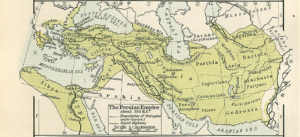Here are some key dates in the history of Persian Empire/ Persian Empire Timeline Chronology Dates: The Persian Empire is the name used to refer to a number of historic dynasties that have ruled the country of Persia (Iran). Persia’s earliest known kingdom was the proto-Elamite Empire,

Followed by the Medes, but it is the Achaemenid Empire that emerged under Cyrus the Great that is usually the earliest to be called “Persian.”
Ancient Persian Empire Timeline
Persian Empire from 612-330 BC
The Persian Empire dominated Mesopotamia from 612-330 BC. The Achaemenid Persians of central Iran ruled an empire which comprised Iran, Mesopotamia, Syria, Egypt, and parts of Asia Minor and India.
The first record of the Persians comes from an Assyrian inscription from c. 844 BC that calls them the Parsu (Parsuash, Parsumash) and mentions them in the region of Lake Urmia alongside another group, the Madai (Medes). For the next two centuries, the Persians and Medes were at times tributary to the Assyrians.
Persian Empire from 653 BC
Around 653 BC, the Medes came under the domination of the Scythians, and the son of Achaemenes, a certain Teispes, seems to have led the nomadic Persians to settle in southern Iran around this time — eventually establishing the first organized Persian state in the important region of Anshan as the Elamite kingdom was permanently destroyed by the Assyrian ruler Ashurbanipal (640 BC).
Persian Empire from 550 BC
The Persian leader, Cyrus the Great, a religious man and adherent of Zoroastrianism, first came to power by overcoming his in-laws, the Medes (c. 550 B.C.) — the conquest made easy by many defectors.
Persian Empire from 539 BC
When Cyrus conquered Babylon in 539 BC he was employed in leading religious ceremonies (Chronicle of Nabonidus), and in the cylinder which contains Cyrus’s proclamation to the Babylonians his name is joined to that of his father in the prayers to Marduk.
Persian Empire from 521 BC
Darius I, who ascended the throne in 521 BC, pushed the Persian borders as far eastward as the Indus River, had a canal constructed from the Nile to the Red Sea, and reorganized the entire empire, earning the title ‘Darius the Great.’
Persian Empire from 550 BC
The Achaemenid Persian empire was the largest that the ancient world had seen, extending from Anatolia and Egypt across western Asia to northern India and Central Asia. Its formation began in 550 B.C., when King Astyages of Media, who dominated much of Iran and eastern Anatolia (Turkey), was defeated by his southern neighbor Cyrus II (“the Great”), king of Persia (r. 559-530 B.C.).
One of the most awe-inspiring monuments of the ancient world, Persepolis was the ceremonial capital of the Achaemenian empire. It was built during the reign of Darius I
Persian Empire from 330 BC
In 330 BC, Macedonian Greeks led by Alexander the Great overthrew the Achaemenids and established what was called the Seleucid Empire after Alexander’s general.